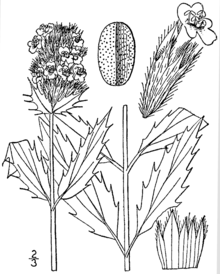Dracocephalum parviflorum
| Dragonhead mint | |
|---|---|

| |
| Dracocephalum parviflorum[1] | |
| Scientific classification | |
| Kingdom: | Plantae |
| Clade: | Tracheophytes |
| Clade: | Angiosperms |
| Clade: | Eudicots |
| Clade: | Asterids |
| Order: | Lamiales |
| Family: | Lamiaceae |
| Genus: | Dracocephalum |
| Species: | D. parviflorum
|
| Binomial name | |
| Dracocephalum parviflorum | |
| Synonyms[2] | |
| |
Dracocephalum parviflorum, known as dragonhead mint or American dragonhead, is a wild North American mint growing across much of the United States (especially in the Great Lakes region and in the deserts and mountains of the West), as well as much of Canada and Alaska.[2][3] It grows as either an annual or biennial, producing clusters of small pink to violet flowers in whorls at the ends of many branching stems. The seeds are small (about 2 mm), dark, and high in oil content, about 20%.
A 2006 study suggests that this mint may have application as a commercial birdseed crop in Alaska.[4]
References
- ^ Britton, N.L., and A. Brown. 1913. An illustrated flora of the northern United States, Canada and the British Possessions. 3 vols. Charles Scribner's Sons, New York. Vol. 3: 114.
- ^ a b "Plants of the World Online | Kew Science". Plants of the World Online. Retrieved 2023-04-29.
- ^ Biota of North America Program, 2013 county distribution map
- ^ Dragonhead mint (Dracocephalum parviflorum Nutt.) as a potential agronomic crop for Alaska, 2006. Bob Van Veldhuizen and Charlie Knight.